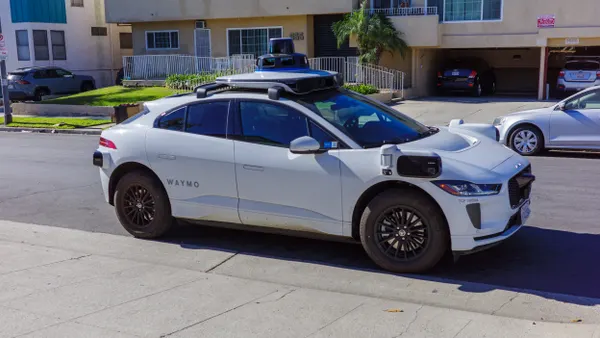Dive Brief:
- Predictive data can help states, counties and cities identify and mitigate driver behaviors that lead to crashes, according to a Sept. 18 report from the Governors Highway Safety Association and Cambridge Mobile Telematics.
- Anonymized telematics data can reveal patterns of phone distraction, hard braking or speeding that can often be addressed with low-cost, quick fixes such as repainting crosswalks and adding or repositioning warning and stop signs.
- The report urges states and transportation departments to enact and enforce proven safety laws such as those for hands-free phone use and seat-belt use.
Dive Insight:
Traffic fatalities in the U.S. began to rise sharply in 2020. Safety organizations have attributed this to speeding, distracted driving and aggressive driving, coupled with a decline in traffic law enforcement.
"We have information that can help save lives now," Ryan McMahon, senior vice president of strategy for Cambridge Mobile Telematics, said in a statement.
Rather than looking back at crash and fatality reports, predictive analytics can expose high-incident behaviors. For example, safety officials can intercede with hyperlocal public awareness campaigns, social media and parental outreach to reduce incidents around schools, the report says.
Telematics-based risk analysis can monitor risk levels in near real time, enabling safety professionals to make continuous improvements, the report states. Automotive insurers use data from connected vehicles and smartphones to monitor driver behavior, in some cases varying insurance rates based on factors such as hard braking, speeding, harsh cornering and acceleration. Telematics data used by the insurance industry have already proven to be credible and predictive, the report says.
The report makes four policy recommendations:
- Federal laws and regulations should encourage state safety officials, Vision Zero programs and other roadway safety partners to integrate validated telematics risk analytics and predictive tools into their safety strategy.
- State elected officials should enact hands-free laws and stronger seat belt laws, supported by public education campaigns to improve driver behavior.
- Include predictive analytics in highway safety plans, measuring whether new laws, engineering changes, enforcement or education campaigns are reducing risky behaviors.
- Ensure accuracy of data and protect personal privacy using externally validated, aggregate risk factors.
"This is an action plan to prevent crashes — not just respond to them," Jonathan Adkins, GHSA’s chief executive officer, said in a statement. "The advanced analytics we outline are validated, predictive, and provide a level of foresight that past generations of safety leaders could only imagine.”













